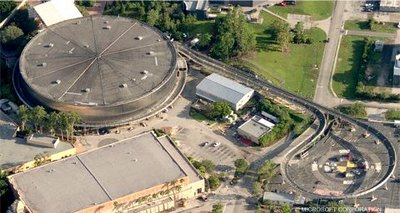While the Focal Exhibit at the Chrysler pavilion, like Epcot’s World of Motion, told the story of the history of transportation, Ford’s main attraction, the Road of Tomorrow, drew parallels to Motion’s successor--Test Track.

A stainless steel sculpture of the god Mercury towered high above the entrance to the Ford building, representing one of the four Ford brands that also included Lincoln and Zephyr. But
 the more striking feature of the building’s exterior was the half-mile spiral ramp on which visitors rode in Ford-model vehicles as a part of the Road of Tomorrow attraction. The ramp surrounded the Garden Court, a beautifully landscaped courtyard where fairgoers could partake in a picnic lunch, listen to a musical performance, or just relax and people watch.
the more striking feature of the building’s exterior was the half-mile spiral ramp on which visitors rode in Ford-model vehicles as a part of the Road of Tomorrow attraction. The ramp surrounded the Garden Court, a beautifully landscaped courtyard where fairgoers could partake in a picnic lunch, listen to a musical performance, or just relax and people watch.Let’s take a look at our guidebook for a quick description of the exhibits inside:
The "Exposition" has four main divisions: the Entrance Hall, the Industrial Hall, the Garden Court, and "The Road of Tomorrow." Each of the first three demonstrate in graphic style some significant phase of the company's work, showing how mass production of automobiles at moderate cost has contributed to a new way of life. The Entrance Hall is dominated by a series of striking exhibits. The first car Henry Ford built will be seen with current models of Lincoln-Zephyr, Mercury and Ford V-8 cars. "Everytown" is a large three phase map activated on a series of synchronized prisms, depicting the changes the automobile has wrought in our country. A huge activated mural by Henry Billings shows how the basic sciences are utilized by industry. Outstanding in the adjoining Industrial Hall is the "Ford Cycle of Production.'' A revolving turntable 100 feet in diameter, it contains 87 exhibits showing the progression of raw materials from earth to finished cars. Industrial Hall also offers various exhibits demonstrating Ford manufacturing methods.
While not sharing the same theme, these exhibits were very similar in design to the Fountain of Information display and the Age of Information animated mural that were a part of Communicore West’s FutureCom area at EPCOT Center.
 The popular highlight of the exposition was The Road of Tomorrow, demonstrated by the long queue lines that overlooked the Garden Court. Here’s how our trusty guidebook described the attraction:
The popular highlight of the exposition was The Road of Tomorrow, demonstrated by the long queue lines that overlooked the Garden Court. Here’s how our trusty guidebook described the attraction:From a broad mezzanine you embark on your wondrous trip over '"The Road of Tomorrow." The winding course takes you through a tunnel lined with murals depicting ultra-modern highway construction, circles the top of Industrial Hall and through still another tunnel high in the nave of Entrance Hall. Descending at last to the second floor level, you circle Garden Court and return to the mezzanine and the end of a thrilling and delightful adventure.
Granted, this “thrilling adventure” did not rival the 65 mph speed of Test Track, but it was certainly entertaining in its day. In fact, Test Track would have been far cooler had the speed ramp circled a public area much the way “Road” surrounded the Garden Court. Instead, it exposes guests to some fairly unattractive backstage scenery.
 Up next: In Part Four, we’ll take a quick look at some of the other Transportation Zone Buildings, then make our way over to General Motors and Futurama.
Up next: In Part Four, we’ll take a quick look at some of the other Transportation Zone Buildings, then make our way over to General Motors and Futurama.

No comments:
Post a Comment